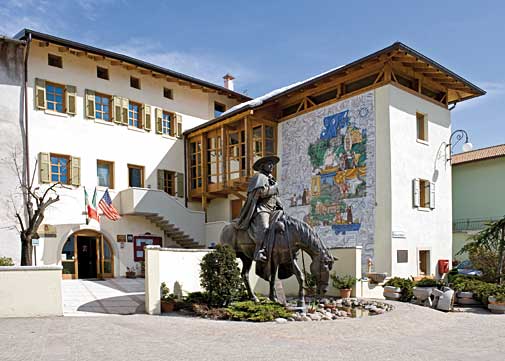INTERVIEW WITH ALBERTO CHINI,
CHAIRMAN OF THE P. EUSEBIO CHINI FOUNDATION
Mariapia Ciaghi

Mariapia Ciaghi. When was the P.E. Chini Association set up and how many members does it currently have?
Alberto Chini. The Father Eusebio Chini Cultural Association was born in 1992 from a Chinian Committee that had been active for some years. We now have 305 members.
 M.C. What activities has the association managed to continue with for the dissemination and understanding of the life and works of the great missionary from Trentino? M.C. What activities has the association managed to continue with for the dissemination and understanding of the life and works of the great missionary from Trentino?
A.C. The Association has undertaken many initiatives in recent years to raise awareness of Father Eusebio. It has edited publications, books, movies about Father Kino; it has worked with students writing their theses on him; it has organised the museum and adorned the Father Kino Cultural Centre with murals by Mexican artist Nereo de la Pena Garcia and a mosaic by Mariano Fracalossi on the facade. It promotes cultural events and performances to spread the life and works of Father Eusebio. In 2008, the statue by artists Livio and Giorgio Conta at the entrance to the town of Segno was unveiled, a statue we wanted to make Father Kino known to all those who pass by. A special effort is being put into supporting Father Dominic Calarco, Vice Postulator of the cause of beatification in progress.
M.C. Each year, more people visit the Father Kino Museum. What does it contain and what items are conserved in the Segno museum?
A.C. Visits to the museum begin at the entrance to the building behind the equestrian statue that reproduces the statue in the Famedio (Temple of Fame) of Washington showing the state of Arizona and the celebration of the inauguration of the equestrian monument in Segno. Upstairs, a room specially equipped for the public with some information panels and a large mural recalls the history of Mexico before and after the arrival of Father Kino. In the adjoining room, you’ll find objects that speak of him as a scientist, explorer, geographer and astronomer:  period instruments (1600-1700) - a compass, astrolabe, Galilean telescope, maps drawn by the Father and sent to Europe for publication, a treatise on comets, tools and costumes donated by the Indians. All surrounded by murals depicting the travels and missions founded by Father Kino and anthropological context of the area in which he carried out his apostolate. Below is a large room devoted to religious and commemorative aspects. The collection includes many books dedicated to Father Kino published throughout the world, and the urn containing the earth where he is buried with a piece of his bone; then there is the act of his baptism, a vestment used for the celebration of Holy Mass, and a precious gift from Magdalena de Kino, the town where his remains rest, which was offered on the occasion of the signing of the twinning between Segno and the municipality of Taio with this location. period instruments (1600-1700) - a compass, astrolabe, Galilean telescope, maps drawn by the Father and sent to Europe for publication, a treatise on comets, tools and costumes donated by the Indians. All surrounded by murals depicting the travels and missions founded by Father Kino and anthropological context of the area in which he carried out his apostolate. Below is a large room devoted to religious and commemorative aspects. The collection includes many books dedicated to Father Kino published throughout the world, and the urn containing the earth where he is buried with a piece of his bone; then there is the act of his baptism, a vestment used for the celebration of Holy Mass, and a precious gift from Magdalena de Kino, the town where his remains rest, which was offered on the occasion of the signing of the twinning between Segno and the municipality of Taio with this location.
M.C. What have been the most significant events organised by the museum and what events are planned for the 300th anniversary of his death?
A.C. 2011 marks the 300th anniversary of the death of Father Eusebio Chini. We are preparing the calendar of events in collaboration with the Province of Trento, in particular with the Department of Culture, to celebrate the figure and works of this illustrious Trentino personage. There are plans for a musical, an international conference, an exhibition of Father Kino’s maps and letters conserved in archives and museums around the world, and a film to disseminate knowledge. The Archbishop of Trento, Mons. Luigi Bressan, has proved to be very sensitive and this will certainly promote the figure of Father Chini during 2011 in support of the cause for his beatification. In 2011, the Vatican City State plans to issue a commemorative stamp, and numerous initiatives are also planned in Arizona and Mexico.
 M.C. The equestrian monument standing in the square in Segno in front of the museum was donated by the authorities of Tucson. What are your relations with Arizona and Mexico, and how are relations with Magdalena de Kino after its twinning with your town in 2008? M.C. The equestrian monument standing in the square in Segno in front of the museum was donated by the authorities of Tucson. What are your relations with Arizona and Mexico, and how are relations with Magdalena de Kino after its twinning with your town in 2008?
A.C. The equestrian monument donated by the Historical Society of Tucson stimulated the Chinian Committee, which became a cultural association. That has allowed us to establish new contacts with Arizona that will strengthen with the passing of time. The twinning with Magdalena de Kino has intensified relations with Mexico. The celebrations of 2011 will offer an opportunity for cultural exchanges, meetings of delegations, and travel between the two continents.
Associazione culturale P.Eusebio Chini
38012 Segno (TN)
www.padrekino.org |
 NUMBER 10
NUMBER 10

 NUMBER 10
NUMBER 10
